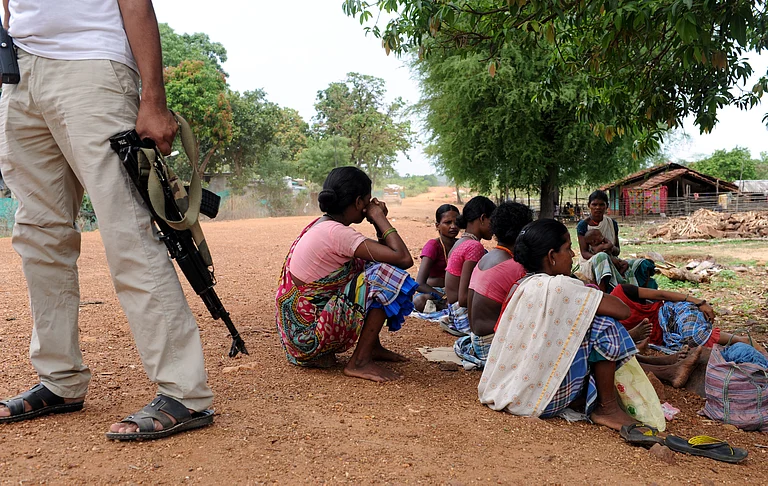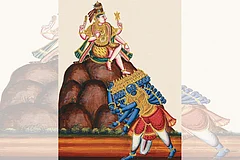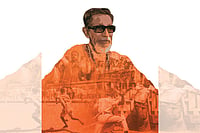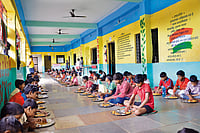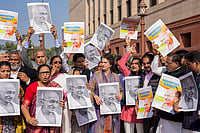In 2017, Korchi taluka in Gadchiroli district of Vidarbha in Maharashtra was gearing up for the Raavan dahan event on Dussehra. It was to be a regular evening with the effigy of the demon king going up in flames, followed by a fireworks show to be organised by the villagers.
Suddenly, tension began to simmer as the Gond Adivasis took out a rally, chanting slogans like ‘Raja Rao Ravana Seva Seva’. The villagers, who were preparing for the Raavan dahan event later in the evening, stopped and questioned those leading the rally. “We told them that Raavan is our god. They should not burn our god as we were not doing the same to their god, Ram,” says Rajaram Netam, a Gond Adivasi and the president of the Gram Mahasangh, a cultural organisation in Korchi.
A heated argument followed, and the quarrelling groups arrived at the police station. When the police asked them about the sudden change of heart towards Raavan, the Adivasis said: “He is our ancestor. We worship him and are taking out a rally to show our devotion to him.”
As the police tried to reason with them that there was no such precedent, some Adivasi activists waved photocopies of pages from books like Kalyug Ramayana and Raja Ravan written by Venkatrao Atram to prove Raavan’s Adivasi ancestry. “Police protection had to be provided to us for the rally, and tension prevailed during the festivities that mark the burning of Raavan’s effigy,” recalls Roopesh Kumre, a Gond Adivasi, who resides in Korchi.

Until 2017, the Gonds would take part in the Raavan dahan ceremony. “We are just 12 km away from the Chhattisgarh border. All these years, artists would come from there to perform Chhattisgarhi dance and narrate Ram katha. We used to enjoy that,” says Netam.
“In 2017, some of our educated youth told us that calling Raavan a rakshas (demon) and burning his effigy is wrong as he was our ancestor and that the scriptures have detailed him as a learned and brave king who was an Adivasi. Now, Raavan is worshipped in Chhattisgarh as well,” he adds.
This belief is not confined to just Korchi. In Maldugi, a small village barely 22 km away, sarpanch Akanksha Netam leads Raavan worship at the ground near her home. “There are around 500 villages in Korchi taluka and across Gadchiroli where Raavan is worshipped. We do ghat sthapna on the day Navratri begins. We worship Raavan for nine days and sing Gondi songs in his praise. On Dussehra, we take out a rally during the day to celebrate our king,” she says.
On the first day of Sharad Navratri, ghat sthapna is performed by the priest in a small hut-like structure made with bamboo. This hut is built on the ground where statues of other tribal icons like Birsa Munda, Krantiveer and Baburao Pulesur are already erected. On Dussehra, the rally culminates at this ground and aarti is performed and prasad is distributed.

It was in 1995 that the villagers in Maldugi began worshipping Raavan. “Motiravan Kangali (a linguist and an author from the Gond community) started this practice in Amravati by organising a Gondi Dharam Sammelan. He visited Maldugi and guided us and said that we are descendants of Raavan, who is also worshipped in other states,” says Sri Ram Keshav Netam, the priest who conducts Raavan puja during the nine days.
Apparently, Raavan worship is a recent development. In these Adivasi villages, this trend began as late as 2000. “Before 2000, we used to go to Chowki Chillhati and Ambagadh Chowki in Chhattisgarh to watch Raavan dahan. We didn’t even know about the Ramayana and what is written in it,” says Raja Ram, who admits that it’s only through WhatsApp that they have learned most of what they believe now.
Traditionally, Adivasis have been worshipping nature since time immemorial. On special occasions like a wedding, housewarming, childbirth and when the sowing season begins, they visit the jungles to worship Buda Dev in the form of a stone. “We do nisarg puja. We sacrifice a goat or hen, according to belief, and offer mahua flowers. This is followed by a community meal,” says Pandurang Masa Tulawi, who now feels compelled to accept Raavan as his god. “His full name was Samrat Raja Ravana Mandavi, which proves that he was an Adivasi. He also killed animals and ate non-vegetarian food. Our culture and lifestyle are much like him. Burning his effigy is like burning our history and culture,” he adds.
“Our way of living by sacrificing animals, eating non-veg food, drinking, dancing and singing are all similar to what we hear about Raavan’s lifestyle.”
Around 150 km from Korchi, at Kamlapur in Aheri taluka of Gadchiroli, the village ghotul is being decked up for the nine- day festival of Raavan worship. A ghotul is a bamboo and mud structure that the Adivasis build in their villages to serve as a community centre where the youth meet and interact.
Sambayya Karpet, the former sarpanch of the village, is busy giving last-minute touches to the place festooned with colourful streamers and decorated with aesthetically drawn patterns on the mud floor. It was in 2014 when he first learned about Raavan being an Adivasi and their god from Gada Nandal, an educated youth who lived in the village. He told Karpet that he had heard it from Satyanarayan Kodape, another learned tribal. He did not believe him then. “I attended a three-day Adivasi meeting of Gond Mandal at Kanker, Chhattisgarh, in 2015, and questioned the speakers there. From them, I learned that Gonds were Pulush Vanshiya, the same as Raavan, according to research done by Sangram Shah, who was a Mandavi,” says Karpet.
He adds that the belief that Raavan was a demon was propagated as he had abducted Sita. “He did not harm Sita. He abducted her to avenge the insult of his sister Surpanakha whose nose was cut by Lakshman,” adds Vinayak Alam, the former sarpanch of another village in Aheri.
Though it’s not clear why this trend suddenly came into being, there is an explanation. “It is now that our youth are getting educated and reading about our history that we are getting to know our ancestors,” says Rishi Portat, a member of the Zila Parishad from Aheri. He doesn’t deny that most of this information is spread through WhatsApp messages.
“It is written in many religious texts that Raavan was a very educated and intelligent king who enjoyed and encouraged art forms, dance and music. He was brave and had immense powers. He was a very devout king whose devotion to Shiva is legendary. We have started worshipping him as we have proof that he was our ancestor, and we admire all his qualities,” says Portat.
So far, the Adivasi community has been worshipping a formless god whom they refer to as Buda Dev or Pirsa Pen. However, there is an image of Raavan before them as he is portrayed in Ram Leela or television serials like Ramayan. At Korchi, a huge flex banner with an image of actor Arvind Trivedi, who played Raavan in the Ramanand Sagar serial Ramayan, telecast on Doordarshan in the eighties, adorns a corner of the office of Korchi Mahasangh. There is a garland of plastic flowers hanging around the flex board, and it is ready to be taken out in the rally on Dussehra.
In Kamlapur and Maldugi, it is the idol of Raavan holding a mace that occupies the place of worship. “Raavan having ten heads is a myth. We feel that the facts about the valour, talent and intelligence of Raavan were deliberately hidden, and events that paint him as a villain were popularised to push back the Adivasi community,” feels Nand Kishore, a teacher in a village school.
The Gond and Mandavi Adivasis are still struggling to understand the truth and admit that they must conduct proper research to authenticate these beliefs. “Our way of living by sacrificing animals, eating non-veg food, drinking, dancing and singing are all similar to what we hear about Raavan’s lifestyle. So, it is easy to believe that he was our ancestor. We still need to know more about this and will need guidance from learned people of our tribe,” he adds.
Though similarities are drawn to associate with Raavan, the contradictions are way too many. It begins with their names, which are taken from variations of Ram’s names. The ghat puja for nine days of worship of Raavan coincides with the Navratri festival. The conduct during these nine days is also what is observed by worshippers of Ram and goddess Durga.
“During the nine days, we do not consume liquor or eat non-veg food. In our evening community meetings, there are no quarrels, and everybody tries to behave well,” says Sambayya Karpat and adds that over 1,000 people from Odisha, Telangana, Madhya Pradesh, Karnataka and Chhattisgarh will be coming to Kamlapur for Raavan puja.
Nand Kishore from Korchi adds: “Ashok Nete, the MP from Chimur in Gadchiroli, also attended one of our rallies, performed Raavan puja and promised to develop a ghotul for this purpose. Nothing has happened so far. The enthusiasm, too, is waning. Like the first two years after 2017, we had a fireworks show, which matched that of Raavan dahan. But subsequently, it has tapered off as we don’t have that kind of money to spend.” For him and his tribe, Raavan is an icon they are willing to accept but have no concrete arguments to stake a claim.
(Views expressed are personal)
MORE FROM THIS ISSUE
Barkha Mathur is a Nagpur-based journalist and author








